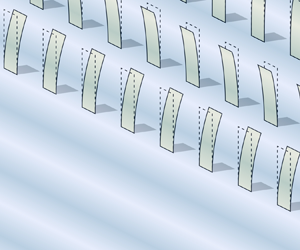
With a view to numerical modelling and optimisation of wave energy farms, a simple recursive formulation is employed to solve for the reflection and transmission of plane water waves by a number of rows of vertical obstacles, under the wide-spacing approximation. The proposed recursive formulation relies on the ‘concatenation’ of any two sets of obstacles, for which the reflection–transmission problem is already resolved. Furthermore, the obstacles are allowed to move in any combination of pitch and surge. The proposed recursive model is validated by means of physical experiments in a small-scale wave flume, whereby waves are reflected and transmitted by one, two and three rows of vertical, flexible blades, taking into account dissipation within the fluid along the wave propagation direction. For the special case of identical, regularly spaced rows, under the adopted formalism, distinct theoretical behaviours are highlighted, depending on whether or not individual obstacles absorb (or dissipate) energy as they interact with incoming waves. In a ‘non-dissipative’ case, the well known fact that discrete values of the row-to-row distance 𝐿 completely cancel reflection is retrieved, as well as the existence of ‘band-gap’ intervals, i.e. intervals for 𝐿 where reflection is high, with maximum reflection occurring away from the Bragg condition. In contrast, when the obstacles dissipate or absorb energy as they interact with the fluid, reflection is always non-zero, and, as the number of rows tends to infinity, forms marked Bragg peaks, reaching unity when 𝐿 is a multiple of half a wavelength.
A wide-spacing approximation model for the reflection and transmission of water waves over an array of vertical obstacles
A. Mérigaud, B. Thiria & R. Godoy-Diana
Journal of Fluid Mechanics 923, A2 (2021)
doi: 10.1017/jfm.2021.532